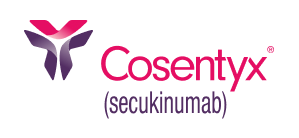
Years of clinical experience
A robust safety profile9
10+ years on the market9‡
NO Boxed WARNING or routine lab monitoring, including liver enzymes9
†The effectiveness and safety of COSENTYX IV formulation are based on the pharmacokinetic exposure and extrapolation of the established effectiveness and safety of SC COSENTYX in adult patients with active PsA, AS, or nr-axSpA.9
‡COSENTYX was originally approved by the FDA in 2015.9
§For SC privately insured patients and IV Medicare Part B FFS patients.
||COSENTYX for SC use is present on formularies as either a first-, second-, third-, fourth-, or fifth-line biologic. Novartis does not guarantee payments or coverage for any product or service. Actual coverage and reimbursement decisions are made by individual payers following the receipt of claims. Coverage information is subject to change by the relevant payer.
¶Based on the total number of covered lives across commercial, Medicare, and Medicaid health plans.
#Medicare Part B FFS typically covers outpatient prescription drugs that are administered incident to a physician service and that are not usually self-administered. For drugs that are available in both oral and injectable forms, the MACs are responsible for determining whether the drug and the route of administration are both medically necessary. Novartis does not guarantee payment or coverage for any product or service. Actual coverage and reimbursement decisions are made by individual payers following the receipt of claims. Coverage information is subject to change by the relevant payer.
**No step therapy or prior authorizations are required.
Definitions
AS, ankylosing spondylitis; FFS, fee-for-service; IL, interleukin; IV, intravenous; MAC, Medicare administrative contractor; nr-axSpA, non-radiographic axial spondyloarthritis; PsA, psoriatic arthritis; SC, subcutaneous.
References
1. Baraliakos X, Gossec L, Pournara E, et al. Secukinumab in patients with psoriatic arthritis and axial manifestations: results from the double-blind, randomised, phase 3 MAXIMISE trial. Ann Rheum Dis. 2021:80(5):582-590.
2. Data on file. CAIN457F2342 (FUTURE 5): 2-Year Interim Report. Novartis Pharmaceuticals Corp; May 2019.
3. Data on file. CAIN457F2342 (FUTURE 5): 2-Year Interim Report. PASI 90 and ACR Components data. Novartis Pharmaceuticals Corp; January 2020.
4. Data on file. CAIN457F2342 (FUTURE 5): 2-Year Interim Report. mNAPSI and PASI 100 data. Novartis Pharmaceuticals Corp; October 2019.
5. Data on file. CAIN457H2315 (PREVENT): Data Analysis Report. Novartis Pharmaceuticals Corp; August 2021.
6. Data on file. CAIN457F2310 (MEASURE 2): Data Analysis Report. Novartis Pharmaceuticals Corp; June 2019.
7. Data on file. CAIN457F2310 (MEASURE 2): Nocturnal Back Pain. Novartis Pharmaceuticals Corp; February 2021.
8. Data on file. CAIN457H2315 (PREVENT): Clinical Study Report. Novartis Pharmaceuticals Corp; November 2019.
9. Cosentyx. Prescribing information. Novartis Pharmaceuticals Corp.
10. Data on file. IL-17 PsA Pharmacy Payer Coverage Data. Novartis Pharmaceuticals Corp; March 2025.
11. Data on file. PsA Medical Payer Coverage Data. Novartis Pharmaceuticals Corp; July 2024.
12. Data on file. CAIN457F2312 (FUTURE 2): Clinical Study Report. Novartis Pharmaceuticals Corp; October 2014.
13. Data on file. CAIN457F2342 (FUTURE 5): Clinical Study Report. Interim Analysis-Week 24. Novartis Pharmaceuticals Corp; November 2017.
14. Sigurgeirsson B, Browning J, Tyring S, et al. Secukinumab demonstrates efficacy, safety, and tolerability upon administration by 2 ml autoinjector in adult patients with plaque psoriasis: 52-week results from MATURE, a randomized, placebo-controlled trial. Dermatol Ther. 2022;35(3):e15285. doi:10.1111/dth.15285
15. Data on file. CAIN457F2310 (MEASURE 2): Clinical Study Report. Novartis Pharmaceuticals Corp; November 2014.
16. Deodhar A, Blanco R, Dokoupilová E, et al. Improvement of signs and symptoms of nonradiographic axial spondyloarthritis in patients treated with secukinumab: primary results of a randomized, placebo-controlled phase III study. Arthritis Rheumatol. 2021;73(1):110-120 and Supplementary Material.
17. Data on file. CAIN457A2313 (TRANSFIGURE): Clinical Study Report. Novartis Pharmaceuticals Corp; November 2015.
18. Data on file. CAIN457A2313 (TRANSFIGURE): Clinical Study Report. Novartis Pharmaceuticals Corp; October 2017.
19. Data on file. CAIN457F2312 (FUTURE 2): Interim Study Report. Novartis Pharmaceuticals Corp; November 2015.
20. Mease P, van der Heijde D, Landewé R, et al. Secukinumab improves active psoriatic arthritis symptoms and inhibits radiographic progression: primary results from the randomised, double-blind, phase III FUTURE 5 study. Ann Rheum Dis. 2018;77(6):890-897.
21. Data on file. CAIN457F3302 (MAXIMISE): Data Analysis Report. Novartis Pharmaceuticals Corp; June 2016.
22. Data on file. CAIN457A2325 (MATURE): Clinical Study Report. Novartis Pharmaceuticals Corp; August 2020.





